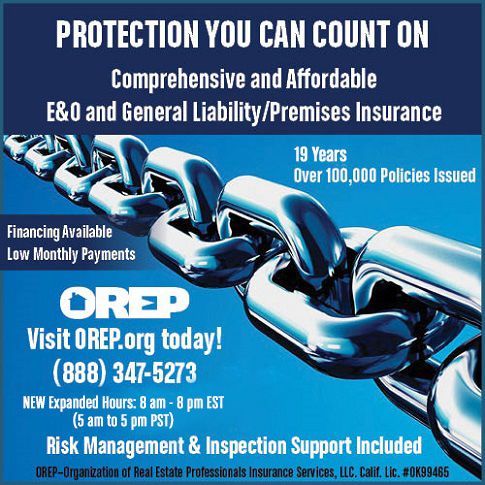 |
> E&O/GL Insurance for Home Inspectors Competitive Rates, Broad Coverage, Free Risk Management, online inspection support for tough questions, discounts on education and more... Professional Coverage, Competitive Pricing Shop OREP today! |
>> Editor’s Note: To help you stay up-to-date and connected, OREP/Working RE has established a Coronavirus (COVID-19) Discussion and Resource Page where you can share your thoughts, experiences, advice and challenges with fellow inspectors. See what Inspectors are saying here!
>> Take the Coronavirus: National Home Inspector’s Survey. Provide your industry feedback.
“Seeing” with an Infrared Camera
by Bill Fabian, Vice President/Senior Trainer at Monroe Infrared
Having taught some 150 infrared certification classes and trained more than 2,000 home inspectors over the last nine years, I often hear the question you may be asking: “What benefit does an infrared camera give me as a home inspector?”
Infrared cameras are often thought of as an expensive and not-so important addition to an inspector’s toolbelt. While that may have been true 8–10 years ago, it is not true today. Here’s why.
While Realtors/agents used to avoid inspectors who used infrared cameras in the past, today they seek out inspectors who not only use an infrared camera but are certified to do so, including how to interpret the thermal images.
We see visible light pictures with our eyes and capture those images with digital cameras. This both documents and exposes defects observed during a home inspection.
An infrared camera “sees” heat energy—not light, not color, not shadows, not new paint, etc. This is very different than what we see with our eyes and why it is so valuable for inspectors to understand how infrared works.
Everything we can see with our eyes and feel through our skin is radiating heat energy that can be seen by a good infrared camera. Absolutely EVERYTHING. And while visually we may not see any defects or flaws, the infrared image can often reveal hidden concerns. Many times a seller may not even know the problem exists. For instance, look at Figure 1a, as seen through the naked eye and Figure 1b, using thermal technology.


Figures 1a and 1b: Kick-out Flashing
Note that the lack of a kick-out flashing allows water to penetrate the EIFS. Under the right conditions this developing issue, which could result in a very serious problem, shows very clearly with an infrared camera but not with the naked eye. Would this be something the seller knew about? Maybe but probably not.
Would this information be important to your client the buyer? Absolutely!
(story continues below)
(story continues)
The infrared camera “sees” something the naked eye cannot—a heat register tiled over! (See Figures 2a and 2b.)


Figures 2a and 2b: Brand new floor with naked eye (top) and with infrared camera (bottom).
And the lists of things found every day using thermal imagery that would have been otherwise missed goes on and on. These are not insignificant items, as we’ve seen. These are defects that could cause your phone to ring some months later with a demand from an unhappy client. You want to discover these issues before the client buys the home, not after.


Figures 3a and 3b: Family room ceiling with naked eye and with infrared camera. Infrared reveals missing insulation in the ceiling of a new home.
Making the decision to invest in an infrared camera and committing to get certification training is a small expense that pays tremendous dividends for years and years! We hear from inspectors all the time who say they paid for their training and IR camera in the first month with increased income or with the first major “OMG” find that may have saved them liability headaches. They also regularly share what they can now identify with an IR camera that they were missing or unable to find before.


Figures 4a and 4b: Ceiling shows leaking water from second floor bathroom plumbing!
Infrared cameras, with the proper training, permit home inspectors to provide a better inspection and provide a higher quality and greater value to their clients. That also means you can charge more because you are providing more than your competitors.
About the Author
Bill Fabian is Vice President of Sales & Training for Monroe Infrared Technology. He has provided infrared training, IR cameras, and thermal inspection services to Maintenance, Utility, Municipal, Federal and Residential Building Performance Inspectors since 1986. Bill works closely with companies of all sizes to ensure the most appropriate training and right equipment are provided to maximize the results of thermal imaging for clients. He has delivered more than 100 presentations and papers on the use of thermal imaging equipment for electrical, mechanical, HVACR, building energy and residential inspection applications to a broad array of audiences across the country.
OREP/WRE Coronavirus Discussion and Resource Page
Coronavirus: National Home Inspector Survey
Free Risk Management Online Course Claims and Complaints: How to Stay Out of Trouble
Available Now
Presenter: David Brauner, Senior Insurance Broker OREP
David Brauner, Senior Broker at OREP, shares insights and advice gained over 25+ years of providing E&O insurance for inspectors, showing you how to protect yourself and your business. Watch Now!
Note: The Summer 2021 issue of Working RE Home Inspector is mailing now to over 25,000 home inspectors nationwide. OREP Insureds enjoy guaranteed delivery of each print magazine and many more benefits.


